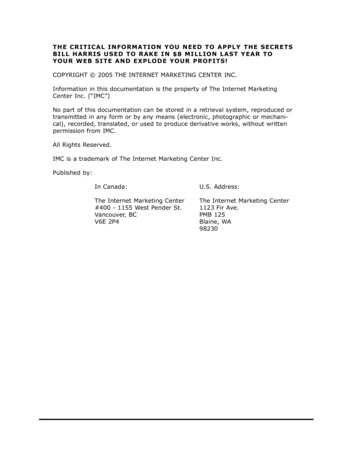
Transcription
CUSTOMER SERVICESKILLS YOU NEED
TABLE OFCONTENTSPhone4Support Tickets and Email6Chat8Social Media10
CUSTOMER SERVICE SKILLS YOU NEEDCUSTOMER SERVICESKILLS YOU NEEDToday’s customer service involves much morethan a conversation on the phone. Web, email,chat, and social media are now very importantchannels for customers. Still, many customersprefer to contact companies with a phone call.From a company’s perspective, the phone is not alwaysthe most efficient channel, particularly for largercompanies dealing with high volumes of customerservice calls.Soft skills for providing customer support on the phone, suchas empathy, the ability to “read” a customer’s emotionalstate, social graces, communication, and friendlinessremain important, but additional skills for the newerchannels need to be developed to make these channelsequally—or more—viable choices for customers.This paper delves into today’s main customer servicechannels and the associated soft skills which make fora rock star agent. Naturally, the skills overlap and canapply to more than one channel.3
CUSTOMER SERVICE SKILLS YOU NEED41Phone Smile, literally. A smile can “translate” through thephone, causing your voice to sound friendly andwarm. But be careful not to “smile” at a very angrycustomer. Wait until the time is right. Mirror your customers. Try to match their toneand emotion. Mirroring doesn’t mean to yell if acustomer is yelling at you. However, an initial increasein volume or intensity might help the interaction atthe start. Then it’s important to quickly bring theintensity down. Be yourself, and mirror in the bestway you can to create quick rapport. Reflect and validate. When a customer is upset orfrustrated, they might not be able to take in what yousay—even when it’s the right answer. First, really listento help them calm down. After saying all they need tosay, they’re more likely to be receptive to hearing thesolution you offer.
CUSTOMER SERVICE SKILLS YOU NEED5 Acknowledge. Tell customers you understand theirproblem and the reason for their call. Make sure theyfeel heard. Give the customer time. Let customers vent if theyneed to, even if you understand the issue right away.People often need to finish expressing themselvesin their own way before they are ready to proceed. Summarize. Repeat back what a customer has toldyou in a supportive way. This demonstrates thatyou understand the problem. Communicate hold time. Before you put someone on hold, get confirmation that it’s OK todo so. General rule: don’t leave a customer onhold more than 2 minutes without checkingback, even if it’s to say it may take longer. If youknow it will be an extended hold, tell them aheadof time. Offer to call back, if that’s preferable.
CUSTOMER SERVICE SKILLS YOU NEED62Support Tickets and Email Hone your writing skills. Tickets and email requireexcellent writing ability. That means writing withclarity, precision, and brevity. Use templates, not boilerplates. Don’t use theexact same prewritten text when responding totickets. Start with a basic, standardized templatespecific to your support team and personalize itwhen replying to customers. Inject personality into responses. Feel free touse your own voice and approach. You canreflect the company’s persona and philosophy inyour own way. Consider using a differentsignature and closing macro based on the toneand resolution of the interaction.
CUSTOMER SERVICE SKILLS YOU NEED7 Aim for specific times. Make sure all tickets areresolved or escalated within a certain time frame.Time to first reply is critical, so define expectationswith your team and with your customers. Systemicalarms and triggers are imperative to ensurethat tickets don’t get stale. If you get an updatefrom engineering, product, or operations, makesure a systematic process exists to updatecustomers. Don’t be robotic. Emails should havepersonality, reflecting the fact that they comefrom an actual person. Prioritize. The ability to prioritize tickets whilekeeping esponse times in mind is immenselyimportant. Mimic phone skills in writing. Smile, mirror,summarize, acknowledge, etc.
CUSTOMER SERVICE SKILLS YOU NEED83Chat Combine phone and email skills. Chat is verysimilar to phone in that it is a conversational,real-time interaction. However, like email, chatrequires strong writing ability. Tone is often difficult to decipher in chat whichtends to be a series of short, quick statements.Therefore, pay close attention to the way things arewritten while chatting. Word choice and a gentle,informative tone are key. A good rule: if you didn’thave the ability to include an emoticon (smiley face),would the recipient understand the tone? Be kindwith your words. Multitask. A seasoned customer service agentcan handle several tickets at once on chat, but thisshould never be done at the expense of providing
CUSTOMER SERVICE SKILLS YOU NEED9your customers with great service. Only take on whatyou can handle. If your customers are waiting morethan a minute or two between responses, thenyou’re effectively putting them on hold. Treatthem the same way you would on a phone call(see above) and give them time expectations. Be a keen reader. As with email and supporttickets, customers are often less able to expressthemselves or explain problems in writing. Readcarefully and ask questions. Don’t jump toconclusions.
CUSTOMER SERVICE SKILLS YOU NEED104Social Media Acknowledge. Make it known that you are aware ofthe customer’s tweet, Facebook post, etc. Make quick contact. Get in touch withcommenters as quickly as possible. (Suggestion:10 minutes.) Publicly acknowledge that you’re following up withthem (within the same 10 minute time frame).Once solved, consider returning to the channel(Twitter, Facebook, etc.) to publicly thank them.(Close the loop!) Don’t respond to baiting, or obvious attempts topull you into a pointless altercation in a public space.Nobody gains from this kind of interaction. Forward “love tweets” (compliments, etc.) to Marketingin case they want to retweet and reach out to thecustomer.
CUSTOMER SERVICE SKILLS YOU NEED11 Respond. For actual support requests, if it’s aquestion you can answer, just respond publicly(rather than asking them for contact info andfollowing up in another channel). It’s much faster. Create tickets. If someone reports an issue that requirestroubleshooting or more information from thatperson, pull the conversation into a ticket andsend them a link to it. In these situations, it’sbetter than engaging in a back and forthconversation on Twitter or Facebook. Simply respondvia a tweet with a link they can use. Thencontinue working with them inside the ticket.No matter what channel you use to communicate withyour customers, always close the loop. This meanskeeping them up to date during every step of theprocess, and following up on resolution to make surethey’re completely satisfied.
Soft skills for providing customer support on the phone, such as empathy, the ability to “read” a customer’s emotional state, social graces, communication, and friendliness remain important, but additional skills for the newer channels need to be developed to make the











